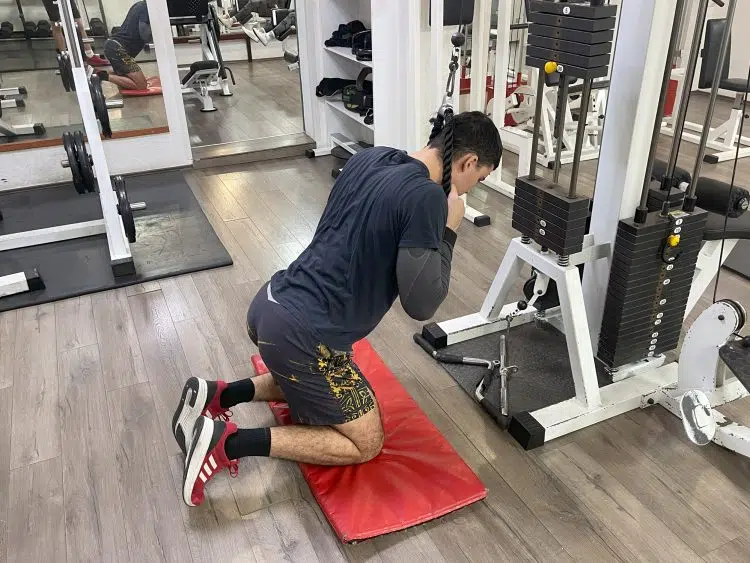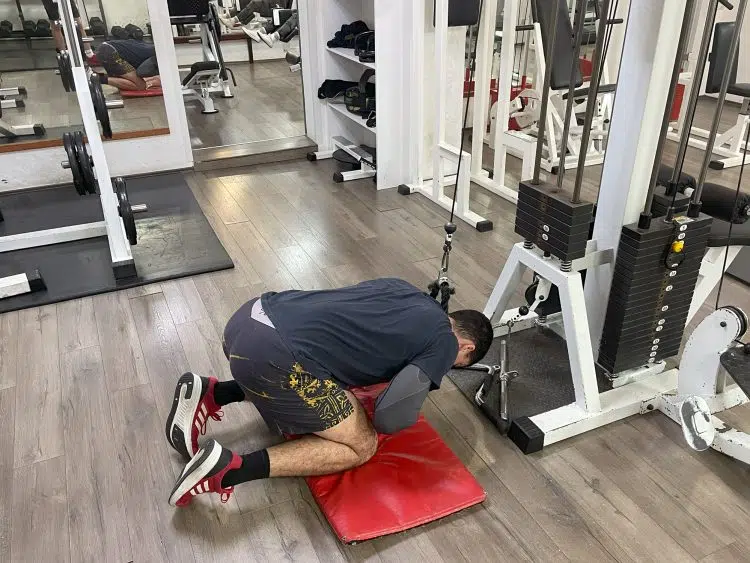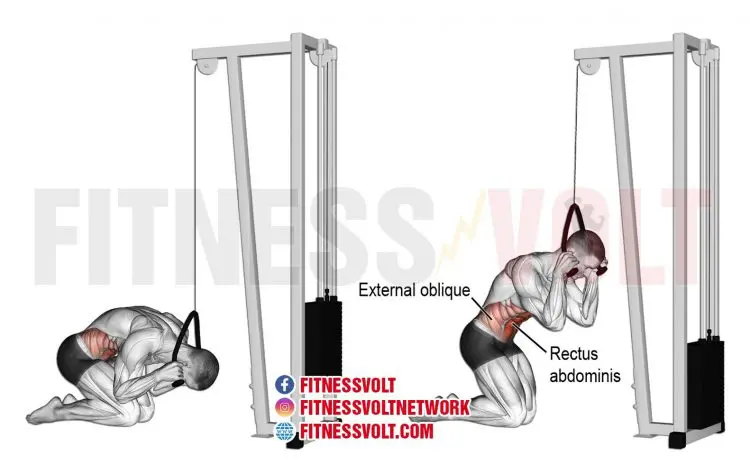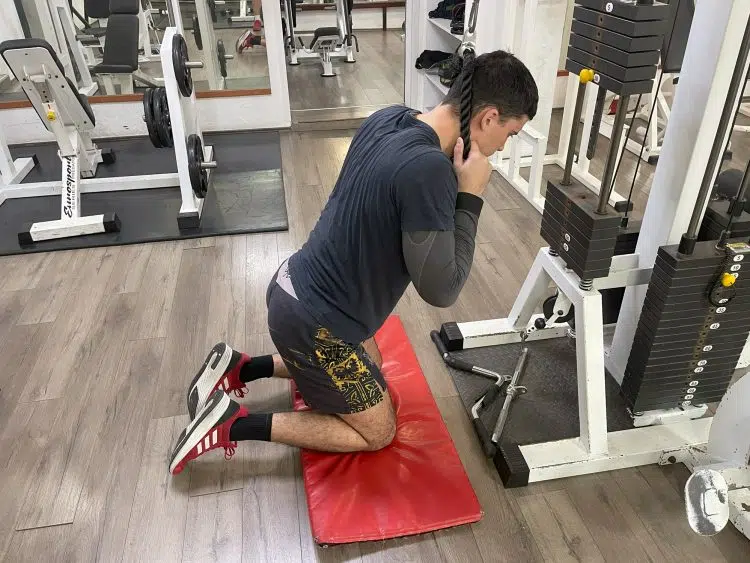The kneeling cable crunch is a phenomenal exercise that will isolate your abdominal muscles and help you build incredible core strength. The core is responsible for stabilizing our entire body, but in my experience as a personal trainer, it is among the most neglected muscle groups.
A study published in Behavioral Sciences (Basel) showed that core training had a great effect on the core endurance and balance of athletes, which can help prevent injuries. (1)
I implement kneeling cable crunches in my clients’ training programs as it is excellent at improving overall core strength and stability. You can find an easy-to-follow guide below so you can perform it to maximize your ab development and avoid injuries.
How To Do a Kneeling Cable Crunch
- Target Muscle Group: Rectus abdominis
- Type: Strength
- Mechanics: Isolation
- Equipment: Cable machine
- Difficulty: Beginner
Here is how to do a kneeling cable crunch correctly:
Step One — Assume the Starting Position
Fasten a rope attachment to a pulley fixed at the highest setting. Place an exercise mat on the floor and kneel on it while grabbing both ends of the rope with a neutral grip (palms facing each other). The center of the rope attachment should be behind your head.
Level Up Your Fitness: Join our 💪 strong community in Fitness Volt Newsletter. Get daily inspiration, expert-backed workouts, nutrition tips, the latest in strength sports, and the support you need to reach your goals. Subscribe for free!
Place your palms against your upper chest and ensure they remain steady during the entire movement.

Pro Tip: I advise my clients to avoid moving their arms during this exercise. This cue ensures their abs are doing most of the work.
Step Two — Lower Your Torso Towards the Floor
Perform a crunch by hinging at your hips and bringing your elbows toward your knees. Keep your abs contracted for maximal target muscle stimulation.
Pause in the fully shortened position for one second before proceeding with the eccentric phase.

Pro Tip: I instruct my clients to exhale sharply during the concentric phase, as it helps stabilize the core and lower back.
Step Three — Return to the Starting Position
Slowly return to the starting position by reversing the motion. Avoid sitting upright at the top of the movement to keep constant tension on your abdominal muscles.
Pro Tip: I get the best results by executing slow, controlled eccentrics. Aim to complete the ascending phase over 3-4 seconds before transitioning to the next rep.
Muscles Worked
The main muscle targetted in the kneeling cable crunch is the rectus abdominis, which is commonly known as the “six-pack.”
The secondary muscles include internal and external obliques and hip flexors.
Tips For Performing Kneeling Cable Crunch
Below are the best tips to drill the kneeling cable crunches:
Start with Lighter Weights
Always start with relatively lighter weights, especially when performing kneeling cable crunches. Since this is an isolation exercise, lifting too heavy can lead to injuries.
Start with a weight with which you can perform at least 10 consecutive reps with a picture-perfect form.
Controlled Tempo
Controlled tempo is crucial for maximal endurance, strength, and muscle hypertrophy gains during kneeling cable crunches. Slow eccentrics can help improve your form and boost mind-muscle connection and time under tension.
Focus on Muscle Contraction
Actively focus on contracting your abs while performing the crunches. Remember, it doesn’t matter how many reps and sets you do if you fail to contract the target muscles.
Breath Control
During concentrics, exhale sharply. During eccentrics, exhale slowly. This will help you perform better due to added intra-abdominal pressure.
Don’t Overextend at the Top
Avoid sitting upright or overarching your back at the top. Instead, reverse the eccentric motion when your torso is at 80 degrees. You might hurt your back if you fail to nail the proper range of motion.
Avoid Neck Strain
To prevent straining your neck, ensure that you do not drive the cable attachment into your neck on concentrics. Instead, imagine your torso is a piece of wooden plank that hinges from the hips.
Level Up Your Fitness: Join our 💪 strong community in Fitness Volt Newsletter. Get daily inspiration, expert-backed workouts, nutrition tips, the latest in strength sports, and the support you need to reach your goals. Subscribe for free!
Common Mistakes To Avoid

Here are some of the most common mistakes people make when performing kneeling cable crunches.
Using Too Much Weight
Using too much weight is one of the most common mistakes, which can lead to back, neck, and disc strains.
Pulling with the Arms
Using your arms to pull the weights can lead to neck strain and hinder the development of your abdominal muscles.
Rushing the Movement
Rushing through the exercise will hinder your progress by removing tension from the target muscles. Start with slow and controlled reps with a 2-3-second eccentric phase for maximal effectiveness.
Incomplete Range of Motion
Many gym-goers perform the kneeling cable crunches using a restricted range of motion, especially on concentrics. This can lead to muscle imbalances and a less functional core. (2)
Kneeling Cable Crunch Variations
Below are some of the best kneeling cable crunch variations:
Standing Cable Crunch
The standing cable crunch is a more functional exercise that will challenge your stabilizer muscles more than the kneeling version. It primarily targets the strongest abdominal muscle (rectus abdominis).
Steps:
- Fasten a rope attachment to a high pulley.
- Assume the starting position with your back to the machine.
- Hold the rope attachment with both your hands behind your neck.
- Bend your hips slightly and perform a crunch, bringing your elbows towards your knees.
- Hold the bottom position for one second and then slowly return to the starting position.
Pro Tip: Avoid using too much weight since you will likely strain your back. Instead, focus on activating your core musculature throughout the movement for the best possible results.
Oblique Cable Crunch
The oblique cable crunch is a highly effective exercise to target the obliques. This exercise mainly entails a twisting crunch movement in the transverse plane, making it highly effective for engaging your internal and external obliques.
Steps:
- Attach a D-handle to a high pulley. It should be at your head level.
- Stand sideways to the cable machine.
- Grab the handle with a neutral grip.
- Slowly and with utmost control, perform a side crunch.
- Hold the isometric contraction for a second.
- Reverse the motion to return to the starting position.
- Change sides upon finishing the entire set on the initial side.
Pro Tip: Avoid using momentum during oblique cable crunches. A slower eccentric phase is a must to target your obliques better. In my experience, beginners must start with lighter weights to drill the movement.
One-Arm Cable Crunch
A one-arm cable crunch is a fantastic unilateral kneeling cable crunch variation.
Steps:
- Attach a D-handle to a high pulley.
- Assume a kneeling position and grab the handle with your right hand.
- Perform a crunch by bringing your right elbow towards your left knee.
- Return to the starting position.
- Repeat for recommended reps before switching sides.
Pro Tip: I always emphasize to my clients the importance of not rushing through the movement. Unilateral exercises demand much greater stability. This is also why it is crucial to squeeze your abs and glutes as hard as possible to maintain stability and achieve maximum exercise effectiveness.
Cable Crunch With Resistance Band
Cable crunch with resistance band is a phenomenal ab exercise because it delivers progressive resistance as you move towards the end range of motion. This is highly useful because the band offers more resistance in the phase where you use the least effort to move.
Steps:
- Secure the resistance band to a high anchor point (the higher, the better).
- Assume the kneeling position and face the anchor point.
- Hold the band with both hands behind your head.
- Perform the crunch motion just like in the cable variations.
Pro Tip: To get the most out of the banded crunches, you must keep your abs contracted throughout the movement. Don’t let the band slack at any point, and squeeze your abs fully at the bottom of each crunch.
Seated Cable Crunch
The seated cable crunch will effectively target your entire abdomen while limiting lower back strain.
Steps:
- Fasten a rope attachment to the pulley at the highest setting.
- Sit on a flat bench facing the cable machine.
- Grab the rope with both hands and extend them above your head.
- Perform a crunch and pause at the bottom.
- Return to the starting position to complete the first rep.
Pro Tip: Even though the bench variation offers more stability than other variations, don’t let it trick you into using more external resistance than you should. Always start with less weight and ensure your feet are firmly placed on the ground for maximum stability.
Wrapping Up
A kneeling cable crunch is a phenomenal exercise for isolating your core. Start with a relatively lightweight and progress after you’ve drilled the movement to maximize performance and avoid injuries.
In the comments below, let me know your thoughts on kneeling cable crunches and how you implemented them in your core workouts.
References:
- Dong K, Yu T, Chun B. Effects of Core Training on Sport-Specific Performance of Athletes: A Meta-Analysis of Randomized Controlled Trials. Behav Sci (Basel). 2023;13(2):148. Published 2023 Feb 9. doi:10.3390/bs13020148
- Schoenfeld BJ, Grgic J. Effects of range of motion on muscle development during resistance training interventions: A systematic review. SAGE Open Med. 2020;8:2050312120901559. Published 2020 Jan 21. doi:10.1177/2050312120901559
Relevant Articles:
Interested in measuring your progress? Check out our strength standards for Cable Crunch, Side Crunch, Standing Cable Crunch, and more.









